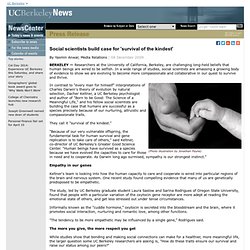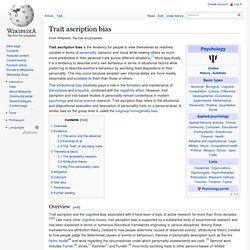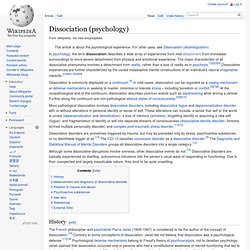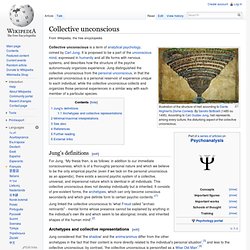

12.08.2009 - Social scientists build case for 'survival of the kindest' By Yasmin Anwar, Media Relations | 08 December 2009 BERKELEY — Researchers at the University of California, Berkeley, are challenging long-held beliefs that human beings are wired to be selfish.

01.31.2006 - Language affects half of what we see. UC Berkeley Press Release Language affects half of what we see By William Harms, University of Chicago, and Robert Sanders, UC Berkeley Media Relations | 31 January 2006 BERKELEY – The language we speak affects half of what we see, according to researchers at the University of California, Berkeley, and the University of Chicago.

Scholars have long debated whether our native language affects how we perceive reality - and whether speakers of different languages might therefore see the world differently. The idea that language affects perception is controversial, and results have conflicted. A paper published this month in the journal Proceedings of the National Academy of Sciences supports the idea - but with a twist. The paper, "Whorf Hypothesis is Supported in the Right Visual Field but not in the Left," is by Aubrey Gilbert, Richard Ivry and Paul Kay at UC Berkeley and Terry Regier at the University of Chicago. Trait ascription bias. Trait ascription bias is the tendency for people to view themselves as relatively variable in terms of personality, behavior and mood while viewing others as much more predictable in their personal traits across different situations.[1] More specifically, it is a tendency to describe one's own behaviour in terms of situational factors while preferring to describe another's behaviour by ascribing fixed dispositions to their personality.

This may occur because peoples' own internal states are more readily observable and available to them than those of others. This attributional bias intuitively plays a role in the formation and maintenance of stereotypes and prejudice, combined with the negativity effect. However, trait ascription and trait-based models of personality remain contentious in modern psychology and social science research. Trait ascription bias refers to the situational and dispositional evaluation and description of personality traits on a personal level. 10 Myths About Introverts. 10 Myths About Introverts By Carl King [ Translations: Spanish | German | Dutch | Italian ] I wrote this list in late-2008.

Around that time, I was lucky enough to discover a book called, The Introvert Advantage: How to Thrive in an Extrovert World , by Marti Laney, Psy.D. Self-handicapping. Self-handicapping is a cognitive strategy by which people avoid effort in the hopes of keeping potential failure from hurting self-esteem.[1] It was first theorized by Edward E.

Jones and Steven Berglas,[2] according to whom self-handicaps are obstacles created, or claimed, by the individual in anticipation of failing performance.[3] Self-handicapping is a widespread behavior amongst humans that has been observed in a variety of cultures and geographic areas. For instance, students frequently participate in self-handicapping behavior to avoid feeling bad about themselves if they do not perform well in class. Self-handicapping behavior has also been observed in the business world, with some researchers even going so far as to speculate that the Enron Scandal came about as a result of the company’s managers using self-handicapping behavior[citation needed].
Dissociation. In psychology, the term dissociation describes a wide array of experiences from mild detachment from immediate surroundings to more severe detachment from physical and emotional experience.

The major characteristic of all dissociative phenomena involves a detachment from reality, rather than a loss of reality as in psychosis.[1][2][3][4] Dissociative experiences are further characterized by the varied maladaptive mental constructions of an individual's natural imaginative capacity. [citation needed] More pathological dissociation involves dissociative disorders, including dissociative fugue and depersonalization disorder with or without alterations in personal identity or sense of self. Although some dissociative disruptions involve amnesia, other dissociative events do not.[15] Dissociative disorders are typically experienced as startling, autonomous intrusions into the person's usual ways of responding or functioning.
Consciousness. Collective unconscious. Collective unconscious is a term of analytical psychology, coined by Carl Jung.

It is proposed to be a part of the unconscious mind, expressed in humanity and all life forms with nervous systems, and describes how the structure of the psyche autonomously organizes experience. Jung distinguished the collective unconscious from the personal unconscious, in that the personal unconscious is a personal reservoir of experience unique to each individual, while the collective unconscious collects and organizes those personal experiences in a similar way with each member of a particular species. Jung's definitions[edit] For Jung, “My thesis then, is as follows: in addition to our immediate consciousness, which is of a thoroughly personal nature and which we believe to be the only empirical psyche (even if we tack on the personal unconscious as an appendix), there exists a second psychic system of a collective, universal, and impersonal nature which is identical in all individuals.
Plutchik wheel (emotions) Cancel Edit Delete Preview revert Text of the note (may include Wiki markup) Could not save your note (edit conflict or other problem).

Please copy the text in the edit box below and insert it manually by editing this page. Upon submitting the note will be published multi-licensed under the terms of the CC-BY-SA-3.0 license and of the GFDL, versions 1.2, 1.3, or any later version. See our terms of use for more details. Add a note Draw a rectangle onto the image above (press the left mouse button, then drag and release). Save To modify annotations, your browser needs to have the XMLHttpRequest object.